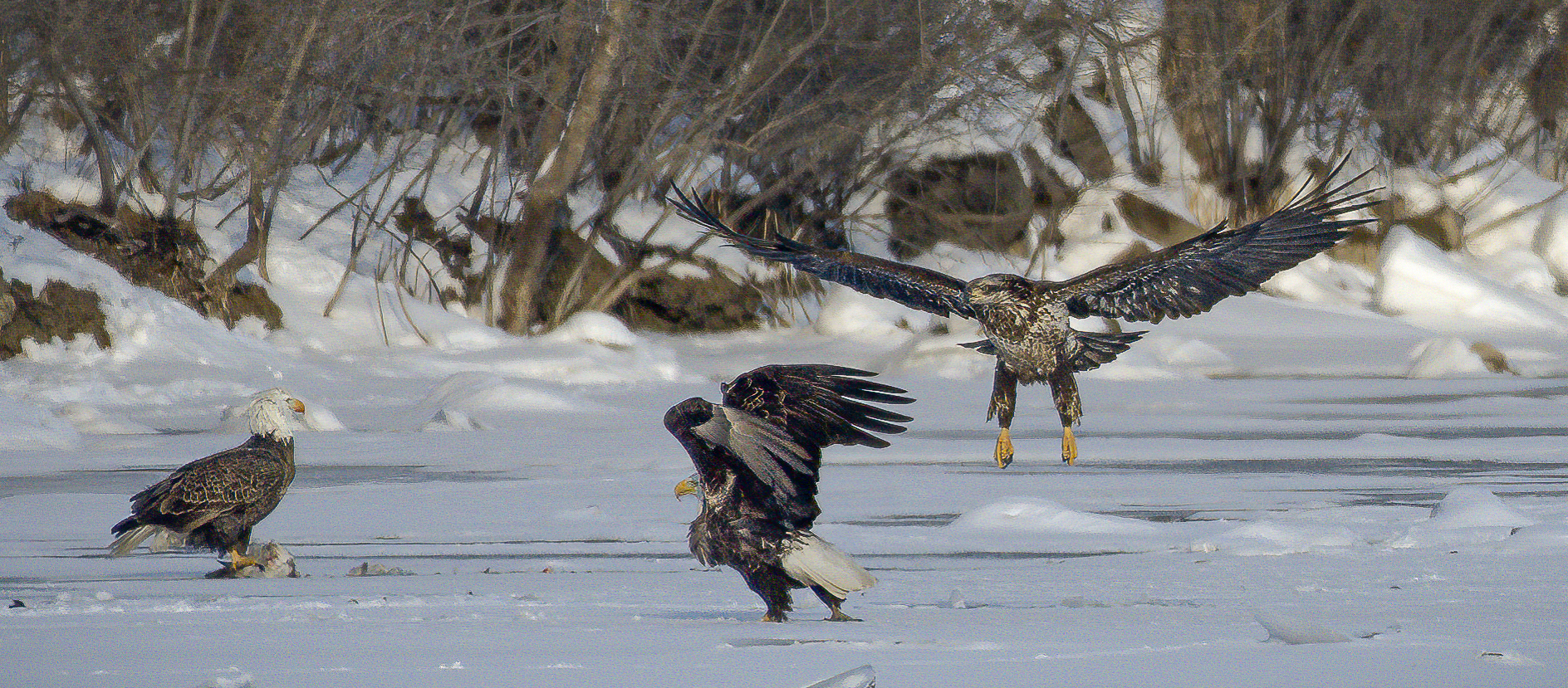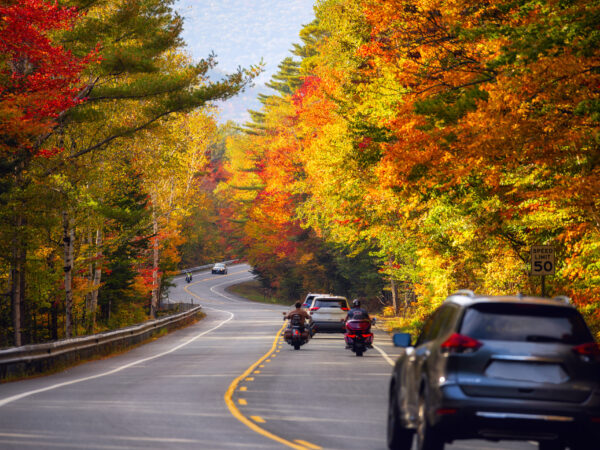
Great Lakes Moment is a monthly column written by Great Lakes Now Contributor John Hartig. Publishing the author’s views and assertions does not represent endorsement by Great Lakes Now or Detroit Public Television.
It was a mid-winter day, and I was driving to my Downriver home from a meeting in Detroit. Out of the corner of my eye I saw a group of 40-50 people standing along the Detroit River shoreline of Dingell Park in Ecorse, Michigan.
My first thought was that they were watching waterfowl staging around Mud Island off the shore of Dingell Park. I wasn’t quite sure, so I made a U-turn and parked my car along Jefferson Avenue right in front to the park. As I started walking toward the crowd, I saw numerous people with large spotting scopes on tripods or cameras with long telephoto lenses all pointed at the upstream end of Mud Island, which is part of the Detroit River International Wildlife Refuge.
Upon reaching this gathering of hearty outdoor enthusiasts, I asked the first photographer I saw, “What’s the deal?” He pointed to the trees on the upstream side of Mud Island where a dozen mature, white-headed bald eagles were perched on the branches of trees.
“The past several years have been great for wildlife photography at Mud Island off Dingell Park in Ecorse where I have seen up to 42 bald eagles in a single day,” said Mark Messer, a professional photographer from Wyandotte, Michigan. “Mud Island has truly become a wildlife photography mecca of the Midwest.” Bald eagles overwinter along the Detroit River where there is open water and plenty of fish to eat. People of all walks of life can come and see firsthand these majestic birds that have been our national symbol since 1782 and have now made such a miraculous recovery that it has been removed from the national list of endangered species.

Photographers gathering at Mud Island. (Photo Credit: Mark Messer)
Bald eagles are birds of prey and prefer fish. They usually mate for life and build large 6 to 8-foot diameter nests at the tops of large trees. They nest in winter when it is easier for us to see the nests because the deciduous trees have lost their leaves. They are well known for their Superman-like vision and imposing razor-sharp talons that they use to grab large fish.
In the early-1900s, naturalists reported that bald eagles were evenly distributed throughout Michigan. The population then declined through the mid-1900s due to loss of nesting habitat and persecution by humans, including shooting, poisoning, trapping and electrocution. This population decline in Michigan accelerated until they were on the brink of extinction in the 1970s. This trend was similar throughout the lower 48 states and southern Canada.
This decreasing trend in bald eagles was a result of several factors, most influential being the increased use of organochlorine compounds such as DDT and PCBs following World War II. These contaminants would increase in concentration moving up the food web – what scientists call biomagnification – and build up in the tissues of top predator bird species, causing reproductive failure, sterility, life-threatening deformities such as crossed bills and egg-shell thinning, altered behavior such as impaired foraging abilities, increased susceptibility to disease through immune system dysfunction, and, in cases of acute poisoning, death.
Reproductive impairment of bald eagles reached a peak in the mid-1970s, resulting in only 38% of Michigan’s bald eagle population successfully fledging young. By 1980, there was complete reproductive failure of bald eagles nesting along the Lake Erie shoreline.
Bald eagle recovery efforts in the United States were initiated with the passage of the first federal endangered species legislation called the Endangered Species Preservation Act of 1966. This act authorized the Secretary of the Interior to list native species of fish and wildlife as endangered and to acquire endangered species habitat for inclusion in the newly established National Wildlife Refuge System.
This act was then renamed the Endangered Species Preservation Act in 1969 to extend protection to animals “threatened with worldwide extinction.” The law that we know today as the Endangered Species Act was then signed in 1973, superseding the earlier acts. This new act broadened and strengthened protection for all plant and animal species listed by the United States as threatened or endangered, prohibited take and trade without a permit, required federal agencies to avoid jeopardizing their survival, and required actions to promote species recovery.
In response to public outcry over the effects of DDT on birds, Michigan became the first state to ban DDT in 1969, three years before it was banned nationally in 1972. As a result of banning DDT and other pesticides that were causing reproductive problems in birds, as well as conservation efforts under the Endangered Species Act, Michigan’s bald eagle population began to recover in the early 1980s.
Southeast Michigan’s bald eagle recovery has paralleled Michigan’s recovery. Based on a coordinated monitoring program between U.S. Fish and Wildlife Service and the Michigan Department of Natural Resources, we know that no bald eagles reproduced in the seven-county region of southeast Michigan between 1961 to 1987 due primarily to organochlorine contamination.
Since 1991, there has been a steady increase in the number of occupied bald eagle nests per year in this region. During 2012 to 2015, at least 25 active nests were documented each year, resulting in the fledging of 28 or more young per year. An average of 1.06 eaglets were fledged per occupied nest in southeast Michigan from 1995-2015, which is indicative of a stable or increasing population and meeting the U.S. recovery goal.
In response to the evidence of recovery of bald eagles throughout the United States, the U.S. Fish and Wildlife Service removed this species from their list of endangered species in 2007.
Today, bald eagles remain federally protected in the United States under the Migratory Bird Treaty Act and the Bald and Golden Eagle Protection Act and they are still classified as a “species of special concern” in Ontario.
Loss of bald eagles from vehicle collisions continues to be a problem and more education is needed to minimize such mortality. Another source of mortality is lead poisoning, related to eagles ingesting lead ammunition fragments from hunter-shot animals, or lead sinkers from fishermen. More effort is also needed to protect existing nesting and foraging habitats. And just like the old adage says that an ounce of prevention is worth a pound of cure, society needs to prevent or minimize the use of organochlorine pesticides and clean up contaminated sediment hotspots.
“Bald eagle populations have rebounded throughout Michigan and the United States largely due to the efforts to clean up our rivers and ecosystems,” said Chris Mensing, fish and wildlife biologist at the U.S. Fish and Wildlife Service. “However, legacy contaminants and contaminants of emerging concern continue to have the potential to impact not only eagles, but how we use our State’s natural resources to birdwatch, fish, hunt and kayak. Continuing to monitor the health of bald eagles in the Detroit River area will ensure that we and our future generations can fully enjoy all of Michigan’s great rivers and woods.”
The recovery of our national symbol needs to be celebrated. Places where you have a good chance of seeing bald eagles include Belle Isle, Humbug Marsh, Point Mouillee State Game Area, Sterling State Park and the Metroparks, so keep your eyes peeled.
Also, each year when there is no pandemic, DTE Energy, the Detroit River International Wildlife Refuge, and the International Wildlife Refuge Alliance host a lottery for a limited number of participants to see as many as 200 bald eagles at the Monroe Power Plant on western Lake Erie.
However, if you are looking right now for a convenient winter natural resource adventure that is sure to provide a bald eagle delight, visit Ecorse’s Dingell Park.
John Hartig is a board member at the Detroit Riverfront Conservancy. He serves as a Visiting Scholar at the University of Windsor’s Great Lakes Institute for Environmental Research and has written numerous books and publications on the environment and the Great Lakes. Hartig also helped create the Detroit River International Wildlife Refuge, where he worked for 14 years as the refuge manager.
Catch more news at Great Lakes Now:
Great Lakes Moment: Overwintering ducks on the Detroit River create a sense of wonder
Great Lakes Moment: Kirtland’s warblers are thriving in Michigan
Featured image: Bald eagles at Mud Island. (Photo Credit: Keith Sutton)




